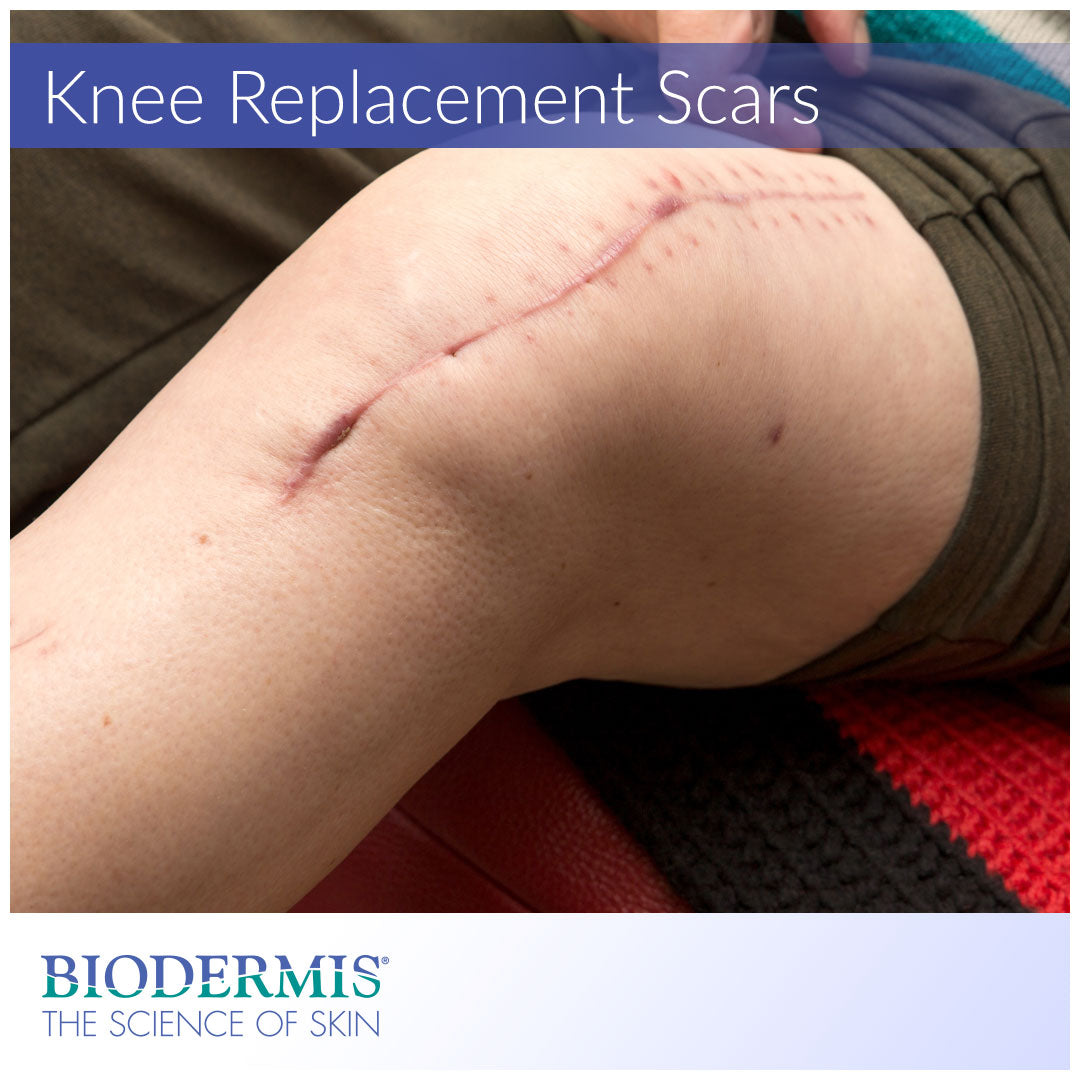Continue reading to learn more about knee replacement surgery and to discover a clinically-proven scar management solution.

Knee anatomy and injury
The knee is the largest joint in the human body situated between the femur (thigh bone) and the tibia (shinbone) of the leg. The knee itself is considered a compound joint because it is responsible for lending support to and providing padding for the femur, tibia and patella (kneecap). Together, this system bears the weight of the body and grants flexion (bending) and extension (straightening) movements to the legs. Because the knee is utilized extensively in movement and carrying our weight, it is prone to injury and wear over time. When this happens, knee replacement surgery is a possible solution to restore motion and reduce joint pain.
Osteoarthritis affects nearly three million people each year and is the leading cause of knee replacement surgery. This condition is marked by the erosion of cartilage and the development of bone spurs (osteophytes) in the joints. Joint cartilage functions as the cushion or padding between two bones. When this padding erodes and the two connecting bones begin rubbing, a person may suffer joint pain, stiffness, and loss of flexibility. People aged 40 years and older are most susceptible to developing osteoarthritis, but not everyone who is diagnosed needs major corrective surgeries. The onset of this disease can be influenced by a number of factors including genetics, obesity, old age, and the repetition of joint-stressing activities.
What is knee replacement surgery?
The first knee replacement surgery was performed in 1968. Since then, many innovations in technique and prosthesis materials have been made to improve the success rate and post-operative knee function. Today, there are roughly 700,000 knee replacements each year, a number that continues to grow annually. In the realm of orthopedic surgery, knee replacements have a high success rate and tend to significantly reduce joint pain and improve knee mobility. The prosthetic device used to replace the damaged knee is made from plastic (polyethylene) and metal components. Such a device is meant to mimic the functionality and purpose of a natural knee joint.

Total and partial knee replacements can be performed in response to the severity of the patient’s condition. Total knee replacements are an appropriate option for patients with severe osteoarthritis that affects the entire knee joint. A partial or unicondylar knee replacement is a viable alternative for patients with less severe joint pain. The knee is made up of three compartments; the type of replacement that will be performed depends on the extent of damage to one or all three compartments. Total knee replacements restore all three compartments, while partial replacements restore only the affected component—usually the medial (inside) compartment of the knee.
Post-operative scar management
Total and partial knee replacements each have their benefits and disadvantages. Recovery time and amount of scarring after total knee replacements are often greater because the procedure is more extensive. Blood thinners are often administered to patients following knee replacement to prevent blood clotting (venous thromboembolism) at the surgery site. Antibiotics and compression garments might also be used to promote rapid recovery and prevent infection.
Patients are encouraged to engage in mild walking exercises with a walker within 24 hours after surgery. Some patients will continue hospital rehabilitation with a physical therapist for up to a week after the procedure. Patients who recover quickly can return home sooner. Full recovery can take anywhere from 3 months to an entire year. Rate of recovery depends on numerous factors like the patient’s age, the extent of the surgery, and the continuation of rehabilitation exercises.
Post-operative scarring is a daunting reality for many knee replacement patients. Surgeons are required to make incisions of up to 10 inches in length to expose the internal mechanisms of the knee. Minimally-invasive procedures may only require an incision of up to 4 inches in length. These incisions leave drastic scarring around the knee that can develop into keloids or hypertrophic scar formations. Scars like these are cosmetically unappealing and can appear raised, lumpy, and discolored. Because scar tissue is devoid of hair follicles and sweat glands, excessive scarring can even feel itchy and painful.

The most effective topical solutions for the prevention and reduction of post-operative scarring are silicone gel sheets and silicone ointments . Medical-grade silicone inhibits scar production by inducing hydration and regulating collagen production at the scar bed. Silicone gel sheets like Epi-Derm long strips and Epi-Derm C-Strips are sized perfectly to cover knee surgery scars. For a unique experience in scar management, try Pro-Sil silicone scar sticks, which come in a convenient glide-on applicator.
Biodermis is an innovative market leader with 30 years of expertise in the medical silicone industry. Visit Biodermis.com today to explore a complete range of scar management and post-operative care solutions.
Biodermis offers custom tailored referral programs designed to simplify and reduce the cost of your patients' post-op care. Additionally, we offer professional pricing if you opt to retail our products. Give us a call at 800.322.3729, and we will be happy to provide additional details on these programs.





